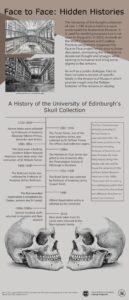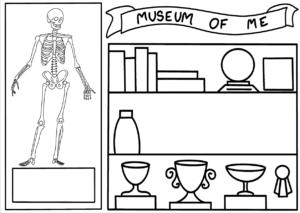(1) Identify your key responsibilities and list the main areas of work you have been involved in. Briefly highlight the skills and competencies that are relevant to this project/work area. [This section should be revised in time for the final submission]
Though my team and I shared many important responsibilities, we split as much as possible into smaller tasks. Jude and I collaborated on some aspects of the graphic design. Fiona and I handled many of the event day logistics, with me handling the creative event and her and Jude, along with Malcolm, running the Anatomical Museum tours. We all rotated doing minutes, agendas, and moderating meetings to ensure everything went smoothly.
Graphic Design and Printing
Using the color scheme of the promotional materials done by Jude, I designed a roller banner for the Anatomical Museum. Part of the goal for this banner was to make it something the museum could use for future open days. The information was gathered from research done by Gaia Duberti that she graciously shared with the group after a meeting I set up. I also worked with Malcolm and Kirsten on the text and timeline.
 Necessary Skills: Creativity, art/design, ability to work with others
Necessary Skills: Creativity, art/design, ability to work with others
Creative Workshop
For the creative workshop, I designed an activity called “Museum of Me” which was designed to be a stress reliever after the Anatomical Museum. I created four different versions featuring two different people, a skeleton, and a LEGO person.

I also ran the creative workshop on the day of the event. People spent about thirty minutes filling in their sheets using markers and pens we provided. I then hung the ones people gave me up on the pin board.
Necessary Skills: Creativity, organization, public speaking
Logistics
For our event, many aspects had to run smoothly. I assisted in dealing with many day-of logistics. I worked with Malcolm to ensure we had tables. I made all of the directional signs for the day and set them up the morning of. We had multiple speakers, moderators, volunteers, and ourselves so I made assigned seats to ensure we all had no problems finding a place to sit. I also worked with our photographer to ensure we got the best quality photos and had photos of every part of the event we were allowed to photograph. After the event, I also did most of the tear-down. I removed all of the signs, cleaned the drinks from the reception, made sure all of our things were out of the lecture theatre and collected all of the surveys.
Necessary Skills: Event management, organization, time management, being calm under pressure
Surveys
After the event, we had 48 surveys. I collected all of these and created a Microsoft Access database to do data entry. I designed the database around the questions we had and then exported the information in an Exel document.
Necessary Skills: Database management, Microsoft Access
(2) Looking ahead, list your key objectives for the GRP. 3-7 SMART (Specific, Measurable, Achievable, Relevant, and Timed) objectives should be noted with realistic timescales and focused outcomes. The objectives should cover the project itself and your own role. [This section should be revised following feedback and finalized before the end of Semester 1]
For this project, a common thread for all of us is the desire to represent the skull collection well and give those in it a voice. Though we all have different ideas for how to go about this. Our brief asks us to find ways to tell the stories of this collection and this is our main objective. Our current plan is a full-day symposium as we believe it is both an achievable goal and a way to represent the collection. For this, we have many less abstract objectives. These include budgeting, marketing, project management, and research. My interest in this is to focus on the project management and research aspects.
Budgeting: Designing a comprehensive budget that allows us to pay speakers, moderators, artists, and photographers, as well as get food, drinks, and materials for the creative workshop.
Survey: Designing a survey that allows us to grade the audience’s reaction to our talks and look back on how their knowledge changed.
Speakers: Finalizing our speakers and getting to know them so we can structure the event in a way that works for all of them.
The Anatomical Museum and lecture theatre: Finding a way to incorporate these two very important parts of the collection and the universities history into the event.
Emotional: To evoke an emotional response from audience members as a way to better understand the collection, without causing distress.
Personal Goals:
For the attendees to gain a greater understanding of the collection and for more awareness of the collection.
(3) Discursive self-reflection: Use this section too, 1) reflect upon the progress of the project to date (both as a whole and with regards to your own specific area/role). 2) Critically reflect upon your experience working with the group. Here you may consider your contribution so far, the value of your specific strengths and expertise, the effectiveness of group communications, and your performance in group meetings. How might the group [have] enhance[d] its performance? [This section should be revised in time for the final submission]
1. A large difficulty for the group was communication, especially during the first semester. Though we were able to turn things around it made working in our group very difficult for a large part of the project. I believe this communication breakdown led to a lot of stress later on in the project. The whole month of January was spent sorting out these problems. We were able to get through it with moderation but I do believe this was a detriment to the overall working environment.
Myself, I believe I did a lot of good work but I also have a tendency to procrastinate. Unfortunately, this did cause me to forget certain things which caused me to be rushing later on. I believe some of my work could have been better, though all in all, I am very happy with how things turned out.
2. I do not believe the members of the group meshed very well. Our communication was not very fluid or natural and was very forced. Though we found ways to work around this, like CCing each other on emails and setting meeting agendas, it was very stressful. I’m not sure if there was a way to completely fix some of these problems other than the tactics we used to work around them. The event went wonderfully even with the problems that we had.
I believe I brought an interesting mix of skills to the group. I have a background in anthropology but also art. Both of these are what drew me to this project. I wish I had gotten to be more creative without fear of reprimand.


Leave a Reply